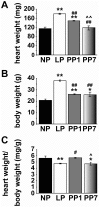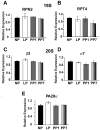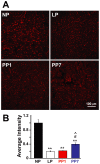Pregnancy is associated with decreased cardiac proteasome activity and oxidative stress in mice
- PMID: 23166589
- PMCID: PMC3499532
- DOI: 10.1371/journal.pone.0048601
Pregnancy is associated with decreased cardiac proteasome activity and oxidative stress in mice
Abstract
During pregnancy, the heart develops physiological hypertrophy. Proteasomal degradation has been shown to be altered in various models of pathological cardiac hypertrophy. Since the molecular signature of pregnancy-induced heart hypertrophy differs significantly from that of pathological heart hypertrophy, we investigated whether the cardiac proteasomal proteolytic pathway is affected by pregnancy in mice. We measured the proteasome activity, expression of proteasome subunits, ubiquitination levels and reactive oxygen production in the hearts of four groups of female mice: i) non pregnant (NP) at diestrus stage, ii) late pregnant (LP), iii) one day post-partum (PP1) and iv) 7 days post-partum (PP7). The activities of the 26 S proteasome subunits β1 (caspase-like), and β2 (trypsin-like) were significantly decreased in LP (β1∶83.26 ± 1.96%; β2∶74.74 ± 1.7%, normalized to NP) whereas β5 (chymotrypsin-like) activity was not altered by pregnancy but significantly decreased 1 day post-partum. Interestingly, all three proteolytic activities of the proteasome were restored to normal levels 7 days post-partum. The decrease in proteasome activity in LP was not due to the surge of estrogen as estrogen treatment of ovariectomized mice did not alter the 26 S proteasome activity. The transcript and protein levels of RPN2 and RPT4 (subunits of 19 S), β2 and α7 (subunits of 20 S) as well as PA28α and β5i (protein only) were not significantly different among the four groups. High resolution confocal microscopy revealed that nuclear localization of both core (20S) and RPT4 in LP is increased ∼2-fold and is fully reversed in PP7. Pregnancy was also associated with decreased production of reactive oxygen species and ubiquitinated protein levels, while the de-ubiquitination activity was not altered by pregnancy or parturition. These results indicate that late pregnancy is associated with decreased ubiquitin-proteasome proteolytic activity and oxidative stress.
Conflict of interest statement
Figures








References
-
- Mone SM, Sanders SP, Colan SD (1996) Control mechanisms for physiological hypertrophy of pregnancy. Circulation 94: 667–72. - PubMed
-
- Dorn GW, Robbins J, Sugden PH (2003) Phenotyping hypertrophy: eschew obfuscation. Circ Res 92: 1171–5. - PubMed
-
- Daniels SR, Meyer RA, Liang YC, Bove KE (1988) Echocardiographically determined left ventricular mass index in normal children, adolescents and young adults. J Am Coll Cardiol 12: 703–8. - PubMed
-
- Pluim BM, Zwinderman AH, van der LA, van der Wall EE (2000) The athlete’s heart. A meta-analysis of cardiac structure and function. Circulation 101: 336–44. - PubMed
-
- Schannwell CM, Zimmermann T, Schneppenheim M, Plehn G, Marx R, et al. (2002) Left ventricular hypertrophy and diastolic dysfunction in healthy pregnant women. Cardiology 97: 73–8. - PubMed
Publication types
MeSH terms
Substances
Grants and funding
LinkOut - more resources
Full Text Sources
Miscellaneous

